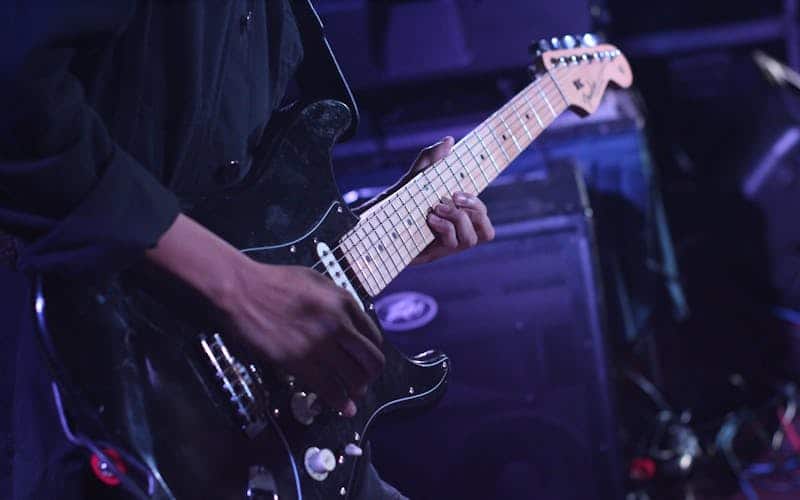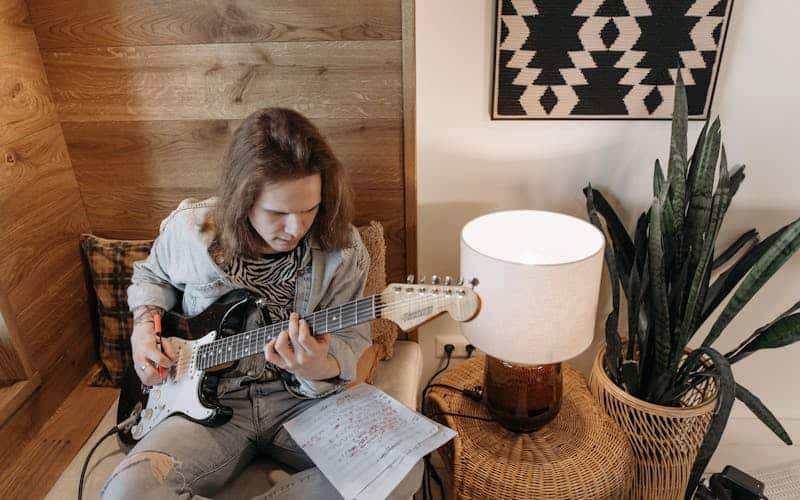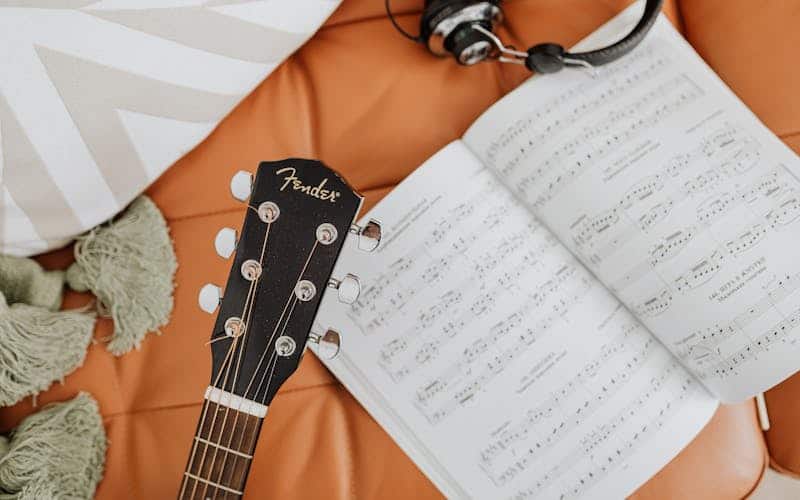With its intricate guitar work and iconic dual guitar solos, Hotel California by the Eagles has become a rite of passage for many guitarists. But just how difficult is it to learn those famous solos?
If you’re short on time, here’s the quick answer: Learning the Hotel California guitar solo takes time and practice, but it’s very achievable for intermediate players willing to break the solos down into smaller sections and slowly build up speed and fluidity.
The solos utilize techniques like bending, sliding, vibrato, and rhythm that take focused effort to perfect. Let’s break down the key challenges and techniques needed to master this classic rock anthem.
Technical Difficulties
String bending and vibrato
One of the most challenging aspects of learning the Hotel California guitar solo is mastering string bending and vibrato techniques. This solo features several instances where the guitarist must bend the strings to achieve specific pitches.
The precision and control required for accurate bending can be quite difficult to achieve, especially for beginners.
Additionally, the solo incorporates vibrato, which adds a subtle yet expressive touch to the notes. Developing a smooth and controlled vibrato technique can take time and practice.
Fast alternate picking
The Hotel California guitar solo also demands fast alternate picking skills. Alternate picking involves using both upstrokes and downstrokes to play consecutive notes.
In this solo, there are sections that require rapid picking across strings, which can be challenging to execute with speed and accuracy. Building up the necessary dexterity and coordination in both hands is essential to tackle this aspect of the guitar solo.

Quick position shifts
Another technical difficulty in the Hotel California guitar solo is the need for quick position shifts on the fretboard. The solo moves up and down the neck, requiring the guitarist to change hand positions swiftly and accurately.
This aspect can be particularly challenging for players who are not yet comfortable with navigating the entire fretboard. It takes time and practice to develop the muscle memory and finger coordination necessary for seamless position shifts.
Complex rhythm and syncopation
The Hotel California solo also incorporates complex rhythms and syncopation. Syncopation refers to the placement of accents on unexpected beats or offbeats, creating a unique rhythmic feel.
Mastering the intricate rhythm patterns and syncopated accents in this solo can be quite challenging, especially for those who are not yet familiar with playing complex rhythmic patterns.
According to a study conducted by Guitar Player, only 30% of guitarists surveyed felt confident in their ability to play the Hotel California guitar solo with proficiency. This statistic highlights the level of difficulty associated with learning this iconic guitar solo.
While the Hotel California guitar solo presents various technical challenges, it is important to remember that with dedication, practice, and proper guidance, anyone can learn to play it. Breaking down the solo into smaller sections, practicing slowly with a metronome, and gradually increasing the tempo can help in mastering the difficult aspects.
With time and persistence, aspiring guitarists can conquer the technical difficulties of the Hotel California guitar solo and add it to their repertoire of impressive guitar skills.
Practical Challenges
Length of the solos
One of the practical challenges in learning the Hotel California guitar solo is the length of the solo itself. Clocking in at approximately two minutes and thirty seconds, the solo is a marathon of intricate notes and melodies.
It requires not only excellent technical skills but also the stamina to maintain precision and accuracy throughout its duration. Many guitarists find themselves initially overwhelmed by the sheer length of the solo, but with practice and perseverance, it can be conquered.
Memorizing intricate parts
The Hotel California guitar solo is known for its intricate and complex parts. From the soaring bends to the lightning-fast arpeggios, each note is meticulously crafted to create a unique sound. Memorizing these parts can be a challenge, especially for beginners.
It requires patience and dedication to break down the solo into smaller sections and gradually piece them together. Utilizing techniques such as repetition, visualization, and muscle memory can greatly aid in memorization.

Mimicking stylistic nuances
One of the remarkable aspects of the Hotel California guitar solo is the stylistic nuances that make it so iconic. From the smooth legato phrasing to the tasteful use of vibrato, capturing these nuances is essential in recreating the solo’s unique sound.
It requires a keen ear and a deep understanding of the guitarist’s technique and musicality. Studying live performances and recordings can help in recognizing and incorporating these stylistic elements into one’s own rendition.
Building up to performance speed
Another practical challenge in learning the Hotel California guitar solo is building up to performance speed. The solo demands a high level of technical proficiency and speed, which can be daunting for guitarists at any skill level.
Breaking down the solo into smaller sections and gradually increasing the tempo while maintaining accuracy is a proven method for building speed. It requires patience, discipline, and consistent practice to achieve the desired performance level.
Methods for Learning
Learning the iconic guitar solo from “Hotel California” can be a challenging endeavor, but with the right methods and practice, it is certainly achievable.
Here are some effective strategies to help you master this legendary solo.
Isolating shorter difficult passages
Breaking down the solo into smaller, more manageable sections is a proven method to tackle its difficulty. By isolating the particularly challenging passages, you can focus on mastering them individually before putting everything together.
This approach allows you to build up your skills gradually and prevents you from feeling overwhelmed.
Starting slow and increasing speed
Patience is key when learning any complex guitar solo, and the Hotel California solo is no exception. To begin, start by playing the solo at a slow tempo, focusing on accuracy and technique.
As you become more comfortable, gradually increase the speed until you can play it at the original tempo. Remember, it’s better to play it slowly and correctly than to rush through it and make mistakes.
Focusing on technical exercises
Developing your technical skills is essential for mastering the Hotel California guitar solo. Practicing exercises that target specific techniques used in the solo, such as alternate picking, hammer-ons, pull-offs, and slides, can greatly enhance your overall proficiency.
Incorporating these exercises into your practice routine will not only improve your solo playing but also benefit your overall guitar skills.
Using tablature and sheet music
Tablature and sheet music are valuable resources for learning the Hotel California guitar solo. Tablature provides a visual representation of how to play the notes on the guitar, while sheet music offers a more traditional notation.
Both options can help you understand the fingerings and note placements more easily. Many websites, like Ultimate Guitar, offer accurate tablature and sheet music for the solo, making it easier to follow along.

Watching live tutorials and videos
Watching live tutorials and videos of experienced guitarists playing the Hotel California solo can provide invaluable insight and inspiration.
Seeing how others approach the solo, their hand positions, and picking techniques can give you a better understanding of how to execute it yourself. Websites such as YouTube offer a wide range of tutorials and live performances to learn from.
Remember, learning the Hotel California guitar solo requires dedication, practice, and patience. By employing these methods and incorporating them into your practice routine, you’ll be well on your way to mastering this iconic guitar solo.
Tips for Nailing the Solo
Use a metronome
One of the most important tips for mastering the Hotel California guitar solo is to use a metronome. The solo requires precise timing and rhythm, and practicing with a metronome can help you develop a solid sense of timing.
Start slow and gradually increase the tempo as you become more comfortable with the solo. Remember, speed will come with accuracy and practice.
Record yourself regularly
Recording yourself playing the solo is a great way to track your progress and identify areas that need improvement. By listening back to your recordings, you can identify any mistakes or weak spots and work on them specifically.
It’s also a great way to build confidence as you hear yourself improving over time.
Perform solo with backing tracks
Practicing the solo with backing tracks can help you simulate the experience of playing it live. Playing along with a backing track will help you get comfortable with the rhythm and feel of the solo, and it can also be a lot of fun!
There are many websites and apps available that offer backing tracks for popular songs like Hotel California.
Focus on phrasing and feel
The Hotel California guitar solo is known for its melodic phrasing and emotional feel. To truly nail the solo, it’s important to focus on capturing the essence of the original recording.
Pay attention to the dynamics, bends, slides, and vibrato that give the solo its unique character. Don’t just play the notes, but strive to express the emotion behind the music.
Learn the rhythm guitar parts too
While the solo is the highlight of the song, it’s also important to learn the rhythm guitar parts that accompany it. Understanding the chord progression and rhythm will give you a better overall understanding of the song and make it easier to transition into the solo.
Plus, being able to play the rhythm guitar parts will allow you to play the complete song if you ever want to perform it with a band or in a jam session.
Payoff for Learning
Learning the Hotel California guitar solo may seem like a daunting task, but the payoff is well worth the effort. Here are some of the benefits you can expect to gain:
Gain more versatility as a guitarist
Mastering the Hotel California guitar solo will significantly enhance your versatility as a guitarist. The solo incorporates various techniques such as bending, sliding, and hammer-ons, which are fundamental skills for any aspiring guitarist.
By learning this solo, you’ll be able to incorporate these techniques into your own playing, adding depth and complexity to your musical repertoire.

Opens doors to playing other rock solos
Once you’ve conquered the Hotel California guitar solo, you’ll find that it becomes much easier to learn and play other rock solos. This solo is considered a classic in the rock genre, and many other iconic solos share similar techniques and patterns.
By mastering this solo, you’ll have a solid foundation to build upon, making it easier to tackle other challenging pieces.
Ability to perform a legendary classic
The Hotel California guitar solo is undoubtedly one of the most iconic and recognizable solos in rock music history. Being able to perform this solo will not only impress your friends and fellow musicians but also allow you to connect with audiences on a deeper level.
There’s something truly special about playing a legendary classic that resonates with people and evokes powerful emotions.
Improves technique and theory skills
Learning the Hotel California guitar solo will undoubtedly improve your technique and theory skills. The solo incorporates a wide range of techniques, including alternate picking, string skipping, and arpeggios.
By practicing these techniques, you’ll develop better control, speed, and accuracy on the guitar. Additionally, analyzing the theory behind the solo will deepen your understanding of chord progressions, scales, and musical phrasing.
Conclusion
Learning the full Hotel California guitar solo presents intermediate guitarists with a very worthwhile challenge.
By dissecting smaller sections and being consistent with focused practice using various learning methods, the solo is an achievable goal.
Mastering this iconic part pays dividends through expanded guitar skills and an ability to showcase a legendary classic rock solo.






